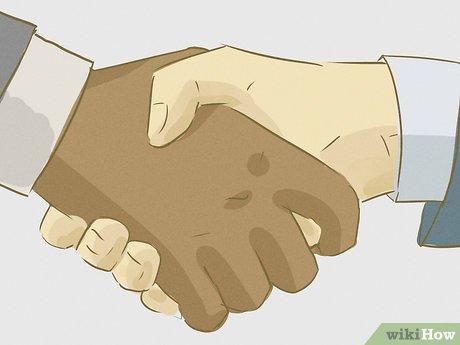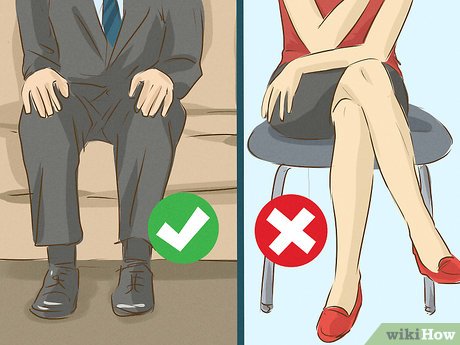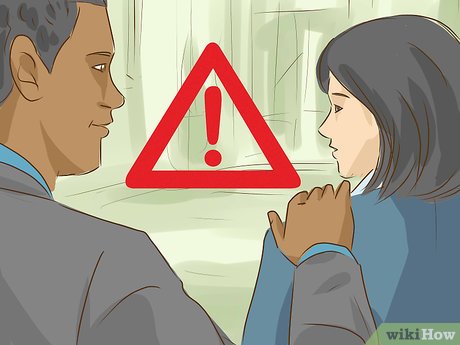How to Communicate Well With People from Other Cultures
Part 1 of 3:
Adopting a Flexible Attitude
-
 Learn about the culture beforehand.[1] A little knowledge can go a long way. If you have time before embarking on a trip or meeting with someone from another culture, try to take time to learn the basic 'do's and dont's' of that culture. You can find information on this from internet sources such as those provided by the National Center for Cultural Competence.[2]
Learn about the culture beforehand.[1] A little knowledge can go a long way. If you have time before embarking on a trip or meeting with someone from another culture, try to take time to learn the basic 'do's and dont's' of that culture. You can find information on this from internet sources such as those provided by the National Center for Cultural Competence.[2] -
 Expect differences. Different cultures will speak at different volumes, be more or less direct in showing emotion, may or may not expect to engage in 'small talk,' and exhibit other dissimilarities in communication.[3] When communicating with people from other cultures, be prepared to encounter such differences, including ones that you were not aware of.
Expect differences. Different cultures will speak at different volumes, be more or less direct in showing emotion, may or may not expect to engage in 'small talk,' and exhibit other dissimilarities in communication.[3] When communicating with people from other cultures, be prepared to encounter such differences, including ones that you were not aware of. -
 Understand hierarchies. When communicating with a different culture, there may be unwritten rules about social hierarchy that you are not used to.[4][5] For instance, you may come from a culture where men and women are expected to communicate equally with each other but may have to interact with someone from a culture where men may do more talking in mixed company. Similarly, you may be communicating with someone who expects that a younger person should let an older person do most of the talking, while you expect people across age groups to communicate equally.
Understand hierarchies. When communicating with a different culture, there may be unwritten rules about social hierarchy that you are not used to.[4][5] For instance, you may come from a culture where men and women are expected to communicate equally with each other but may have to interact with someone from a culture where men may do more talking in mixed company. Similarly, you may be communicating with someone who expects that a younger person should let an older person do most of the talking, while you expect people across age groups to communicate equally. -
 Be upfront about difficulties in communication. If you could not understand someone or think that he or she did not understand you, say something about it. Avoid being rude or offensive, but patiently explain the problem. It's usually better to be upfront than to let a problem in communication go undressed, since there may otherwise be bigger problems later.
Be upfront about difficulties in communication. If you could not understand someone or think that he or she did not understand you, say something about it. Avoid being rude or offensive, but patiently explain the problem. It's usually better to be upfront than to let a problem in communication go undressed, since there may otherwise be bigger problems later.- If you think you did not understand what someone meant, try saying something like: 'I'm not sure I understood you. Could we go over that again?'
- If you think that someone did not understand you, try saying something like: 'Let's review things to make sure we're all on the same page.' You can also make sure to let the person know to ask questions.
-
 Be respectful and tolerant. Each culture has its own set of dominant values, beliefs, and prejudices. Signs of these may emerge when communicating with people from other cultures. Basic communication, however, it is not the time to judge people based on these differences. Instead, respect them for what they are, and tolerate them.[6] You may even learn something new.
Be respectful and tolerant. Each culture has its own set of dominant values, beliefs, and prejudices. Signs of these may emerge when communicating with people from other cultures. Basic communication, however, it is not the time to judge people based on these differences. Instead, respect them for what they are, and tolerate them.[6] You may even learn something new.- Even if cultural differences come up explicitly in conversation, be tolerant and open-minded instead of argumentative. For instance, if you are American and someone comments on Americans' tendency to be work-focused, say something like: 'Yes, it's true that many Americans take work seriously, and there are a lot of reasons for that. Why don't you tell me some more about how your culture thinks about work?'
EXPERT TIP"Remember: innovation, creativity, and intelligence are age-free, culture-free, color-free, and gender-free."
Maureen Taylor is the CEO and Founder of SNP Communications, a corporate communications firm based in the San Francisco Bay Area. She has been helping leaders, founders, and innovators in all sectors hone their messaging and delivery for over 25 years.
Maureen Taylor
Public Speaking Expert Maureen Taylor
Maureen Taylor
Public Speaking Expert -
 Be patient. Communicating with people from other cultures can be enlightening and rewarding, but also have its difficulties. Expect that not everything will come out quite right or be fully understood. Be patient with others, and ask them to be patient with you.
Be patient. Communicating with people from other cultures can be enlightening and rewarding, but also have its difficulties. Expect that not everything will come out quite right or be fully understood. Be patient with others, and ask them to be patient with you.
Part 2 of 3:
Communicating Verbally
-
 Speak clearly and slowly, if necessary. Refrain from shouting unnecessarily or treat others as though they do not understand.[7] Raising your voice does not make you easier to understand and can be seen as rude. Likewise, even if there are difficulties in communicating with people from other cultures, do not treat other people as though they are unintelligent. Communication difficulties arise from cultural differences, not because of matters of intelligence.
Speak clearly and slowly, if necessary. Refrain from shouting unnecessarily or treat others as though they do not understand.[7] Raising your voice does not make you easier to understand and can be seen as rude. Likewise, even if there are difficulties in communicating with people from other cultures, do not treat other people as though they are unintelligent. Communication difficulties arise from cultural differences, not because of matters of intelligence. -
 Be proper. Be polite and use formal modes of address until it is made clear that you don't need to (such as a business contact telling you to use first names).[8] Depending on the cultures that are interacting, this may include addressing others:
Be proper. Be polite and use formal modes of address until it is made clear that you don't need to (such as a business contact telling you to use first names).[8] Depending on the cultures that are interacting, this may include addressing others:- By first and last name
- By last name alone
- With a title such as 'Mr.' or 'sir'
- Using formal pronouns, if they exist in the language used for communicating
-
 Brush up on your foreign language skills. If you will be communicating with people who speak a different language, try to learn a few basic phrases beforehand. Your situation may not require you or permit you to become fluent in a foreign language, but you can still try to learn some.
Brush up on your foreign language skills. If you will be communicating with people who speak a different language, try to learn a few basic phrases beforehand. Your situation may not require you or permit you to become fluent in a foreign language, but you can still try to learn some.- Practice the basics, including: 'Hello,' 'Please,' 'Thank you,' 'How are you?,' etc.
- Carry a phrase book or electronic device that can help you find phrases you need and don't know.
- Be patient when others are trying to use your language.
-
 Try to use the dominant language if you are in the linguistic minority. If you are communicating with people who speak a different language, try to use their language at first, or as much as you can. Even if you can't say much more than 'hello' and 'how are you?' in their language, the gesture is usually appreciated.
Try to use the dominant language if you are in the linguistic minority. If you are communicating with people who speak a different language, try to use their language at first, or as much as you can. Even if you can't say much more than 'hello' and 'how are you?' in their language, the gesture is usually appreciated. -
 Avoid slang and profanity. This is important, unless you are absolutely sure how it is used in another culture. Using non-standard or obscene language improperly can make you hard to understand, and may be perceived as very offensive. Since a language's slang and profanity are complex and highly dependent on context, it is best to avoid them altogether unless you are absolutely sure you know to use them properly.
Avoid slang and profanity. This is important, unless you are absolutely sure how it is used in another culture. Using non-standard or obscene language improperly can make you hard to understand, and may be perceived as very offensive. Since a language's slang and profanity are complex and highly dependent on context, it is best to avoid them altogether unless you are absolutely sure you know to use them properly.
Part 3 of 3:
Using Non-Verbal Communication
-
 Use 'open-handed' gestures. In some cultures, pointing with an index finger, giving the 'ok' sign, and other common gestures can be seen as offensive.[9] Since you may not know which gestures could be mistaken in this way, stick to 'open-handed' gestures.[10] For instance, try using your whole hand if you need to point to something.
Use 'open-handed' gestures. In some cultures, pointing with an index finger, giving the 'ok' sign, and other common gestures can be seen as offensive.[9] Since you may not know which gestures could be mistaken in this way, stick to 'open-handed' gestures.[10] For instance, try using your whole hand if you need to point to something. -
 Assume a formal posture at first.[11] Keep your feet on the floor, sit up straight, don't use your arms too expressively, and otherwise keep your posture more or less conservative. This is because certain postures can be seen as offensive to others. For instance, showing your foot in some cultures is seen as a rude gesture, so you would not want to cross your legs in a way that your sole sticks out.[12]
Assume a formal posture at first.[11] Keep your feet on the floor, sit up straight, don't use your arms too expressively, and otherwise keep your posture more or less conservative. This is because certain postures can be seen as offensive to others. For instance, showing your foot in some cultures is seen as a rude gesture, so you would not want to cross your legs in a way that your sole sticks out.[12]- If it becomes clear that a less formal posture is acceptable, you can follow suit.
-
 Understand rules regarding touching. Some cultures may expect more physical contact between people when communicating than other cultures do. For example, some cultures may shake or touch hands more willingly than others.[13]
Understand rules regarding touching. Some cultures may expect more physical contact between people when communicating than other cultures do. For example, some cultures may shake or touch hands more willingly than others.[13]- Don't take it as offensive if another culture is more or less physical than you are used to when communicating. The exception is if you think you are being violated or abused. If you are uncomfortable, let others know.
- It's a good rule of thumb to be conservative with the way you touch people from other cultures when communicating with them. However, if they appear to use more physical contact, follow suit if you are comfortable doing so.
-
 Know how to make or avoid eye contact. In some cultures, looking another person in the eye when you speak is seen as a sign of honesty and interest. In other cultures, however, it may be seen as disrespectful, confrontational, or a sign of sexual interest.[14] Conversely, some cultures think than not looking a superior person in the eye when communicating is a sign of respect.[15]
Know how to make or avoid eye contact. In some cultures, looking another person in the eye when you speak is seen as a sign of honesty and interest. In other cultures, however, it may be seen as disrespectful, confrontational, or a sign of sexual interest.[14] Conversely, some cultures think than not looking a superior person in the eye when communicating is a sign of respect.[15] -
 Expect different facial expressions.[16][17] It is common for different cultures to use facial expressions differently. For instance, Americans may smile frequently, while other cultures may see excessive smiling as a sign of shallowness. When communicating with people from other cultures, you may notice that they are more expressive with their face (to show happiness, sadness, frustration, etc.) than you are used to, or you may notice that they do not show much expression at all.
Expect different facial expressions.[16][17] It is common for different cultures to use facial expressions differently. For instance, Americans may smile frequently, while other cultures may see excessive smiling as a sign of shallowness. When communicating with people from other cultures, you may notice that they are more expressive with their face (to show happiness, sadness, frustration, etc.) than you are used to, or you may notice that they do not show much expression at all.- Much communication is non-verbal, no matter what the culture. However, you can focus on the content of what is being said, and ask questions to clarify if you need to. For instance, if someone reacts to something you say with an unexpected smile or laughter, you may need to say 'Actually, I'm being I'm serious.'
-
 Respect the amount of personal space the situation requires.[18] Some cultures may require more personal space than others. If you are communicating with people from another culture and you find they get closer to you or farther away from you than you are used to, it's not necessarily the case that they are invading your space or trying to avoid you. Just try to follow their cues regarding personal space and communicate as best you can.
Respect the amount of personal space the situation requires.[18] Some cultures may require more personal space than others. If you are communicating with people from another culture and you find they get closer to you or farther away from you than you are used to, it's not necessarily the case that they are invading your space or trying to avoid you. Just try to follow their cues regarding personal space and communicate as best you can.
4.5 ★ | 2 Vote
You should read it
May be interested
- How to join Rplace on Reddit
 rplace events are a fun way for people around the world to connect and create artwork. it is also a way to explore different cultures and communities.
rplace events are a fun way for people around the world to connect and create artwork. it is also a way to explore different cultures and communities. - NASA can now communicate with its spacecraft using lasers
 nasa is having a tough time communicating with its equipment in space: the radio frequencies that spacecraft use to communicate are getting too busy.
nasa is having a tough time communicating with its equipment in space: the radio frequencies that spacecraft use to communicate are getting too busy. - Learn how Jews teach children to communicate from a young age
 in addition to teaching children asset management, independence, management skills, overcoming difficulties, fostering communication skills for children is also highly valued by jews in the process of educating their preschools. country.
in addition to teaching children asset management, independence, management skills, overcoming difficulties, fostering communication skills for children is also highly valued by jews in the process of educating their preschools. country. - Communicate with LinkedIn members
 in this tutorial, we will introduce you to the basics of linkedin and some ways to communicate with other members.
in this tutorial, we will introduce you to the basics of linkedin and some ways to communicate with other members. - Try these 13 psychological tricks to easily communicate with people
 take a look at the 13 psychological tips below - extremely useful tips for making you a more engaging and interesting communicator in the eyes of others. invite you to consult!
take a look at the 13 psychological tips below - extremely useful tips for making you a more engaging and interesting communicator in the eyes of others. invite you to consult! - Decipher the strange behavior often seen in dogs
 let's learn some of the behaviors that puppies often do to understand more about these close friends of humans.
let's learn some of the behaviors that puppies often do to understand more about these close friends of humans. - Top 10 jobs are best suited for people who talk a lot
 finding a job that suits your specialization and interests is very lucky for everyone. if you are a person who talks a lot or likes to communicate with people, the following 10 occupations will be suitable for you.
finding a job that suits your specialization and interests is very lucky for everyone. if you are a person who talks a lot or likes to communicate with people, the following 10 occupations will be suitable for you. - 7 'indispensable' body language of successful people
 remember 7 indispensable body language of successful people!
remember 7 indispensable body language of successful people! - How to remove calluses on limbs
 calluses on the hands and feet are not easily lost, making many people lose confidence when starting to communicate.
calluses on the hands and feet are not easily lost, making many people lose confidence when starting to communicate. - Instructions on how to connect Skype with Facebook
 skype is currently the application used by many people, it can help people to communicate, talk, text ... share photos quickly. skype also provides a feature to connect with your facebook account, help you chat, track cough
skype is currently the application used by many people, it can help people to communicate, talk, text ... share photos quickly. skype also provides a feature to connect with your facebook account, help you chat, track cough





























 How to Write a Progress Report
How to Write a Progress Report How to Put a Stamp on an Envelope
How to Put a Stamp on an Envelope How to Write a Case Study
How to Write a Case Study How to Write a Paper
How to Write a Paper How to Start a Revolution
How to Start a Revolution How to Conduct Audience Analysis
How to Conduct Audience Analysis